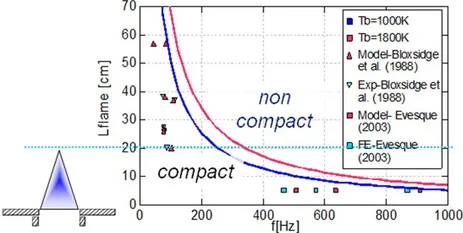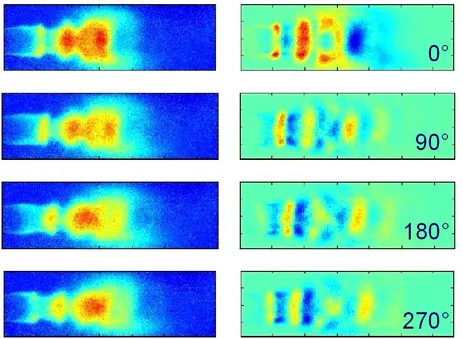Low Order Model and Stability Analysis of Non-Compact Flames
by R. E. Leandro and Wolfgang Polifke
Motivation and Goals
With the development of lean- premixed combustion technologies thermo- acoustic combustion instabilities have become a recurrent problem. In low-order modeling of such instabilities [1] the Flame Transfer Matrix (FTM) relating the acoustical properties upstream and downstream of the flame is obtained starting from a Flame Transfer Function (FTF), that relates the acoustic fluctuations of velocity at the burner with the heat release rate of the flame, and then assuming the flame as an acoustically compact element. This compactness assumption is only valid for Helmholtz numbers He=kL flame << 1, where k is the wave number and L flame the flame length. This work a) explores ways to extend the applicability of low-order models to non-compact conditions and b) evaluates the damping potential of distributed heat release on the thermo- acoustic stability of a combustion system.

Strategy
The non-compact flame response will be determined through the experimental campaign and Large Eddy Simulation (LES) calculations. These two methods will provide input data to the extended low order flame models and the Finite Volume (FV) acoustic formulations. After cross-validation of the resulting FTM(s), a stability analysis of the combustion system used in the experiments will be done.

Low order modeling
In order to account for a distributed reaction zone on a thermo-acoustic network, two different approaches are considered: a discretization of the flame as a sequence of N compact flames or a Helmholtz number multipole expansion [2]. The discretized flame approach is expected to require a higher number of elements as the ratio L flame/ &lambda increases, while the performance of the multipole- expansion with the inclusion of time lags is, to the authors knowledge, still yet to be evaluated.
Experiments
The fully premixed methane- air flame is stabilized on a conical bluff-body, inside a square cross section combustion chamber. The spatial distribution of heat release rate and CH* chemiluminescence is controlled through use of different bluff bodies, and the spatially resolved FTF is obtained combining pressure measurements with CH* chemiluminescence images (Fig. 3) and global OH* chemiluminescence.

Numerical Calculations
Two types of Finite Volume (FV) calculations are considered: a FV Helmholtz solver, where the acoustical field with a sound source coming from an n-&tau flame model [1] is solved and a FV LES solver, that provides the solution of the reactive flow field including the acoustical field. The experimental FTF results will ideally be used to validate these LES computations.
Project partners
The AETHER project [3] is a collaborative research and training network in the field of aero- and thermo-acoustics, with 14 partners from 8 European countries. Close cooperation in the form of secondment of researchers has been done between TUM/TD, the University of Cambridge and CERFACS and will continue on the current project framework.
Acknowlegment
This project is funded by the Fundação para a Ciência e a Tecnologia (Portugal), the European Social Fund and the European Comission in the framework of QREN/ POPH national programme (FSFRH-BD-71479-2010) and the Marie Curie RTN project AETHER (MRTN-CT-2006-35713), whose support is gratefully acknowledged.
References
[1] Polifke, W., "System modeling and stability analysis", In Basics of aeroacoustics and thermoacoustics, VKI Lecture Series 2007-09, Rhode-St-Genese, 2007.
[2] Lieuwen, T. and Zinn, B. T., Application of multipole expansions to sound generation from ducted unsteady combustion processes. J. Sound Vib., 253:405-414, 2000.
[3] AETHER: Aero-acoustical and thermo-acoustical coupling in energy processes. http://www.cerfacs.fr/aether/
